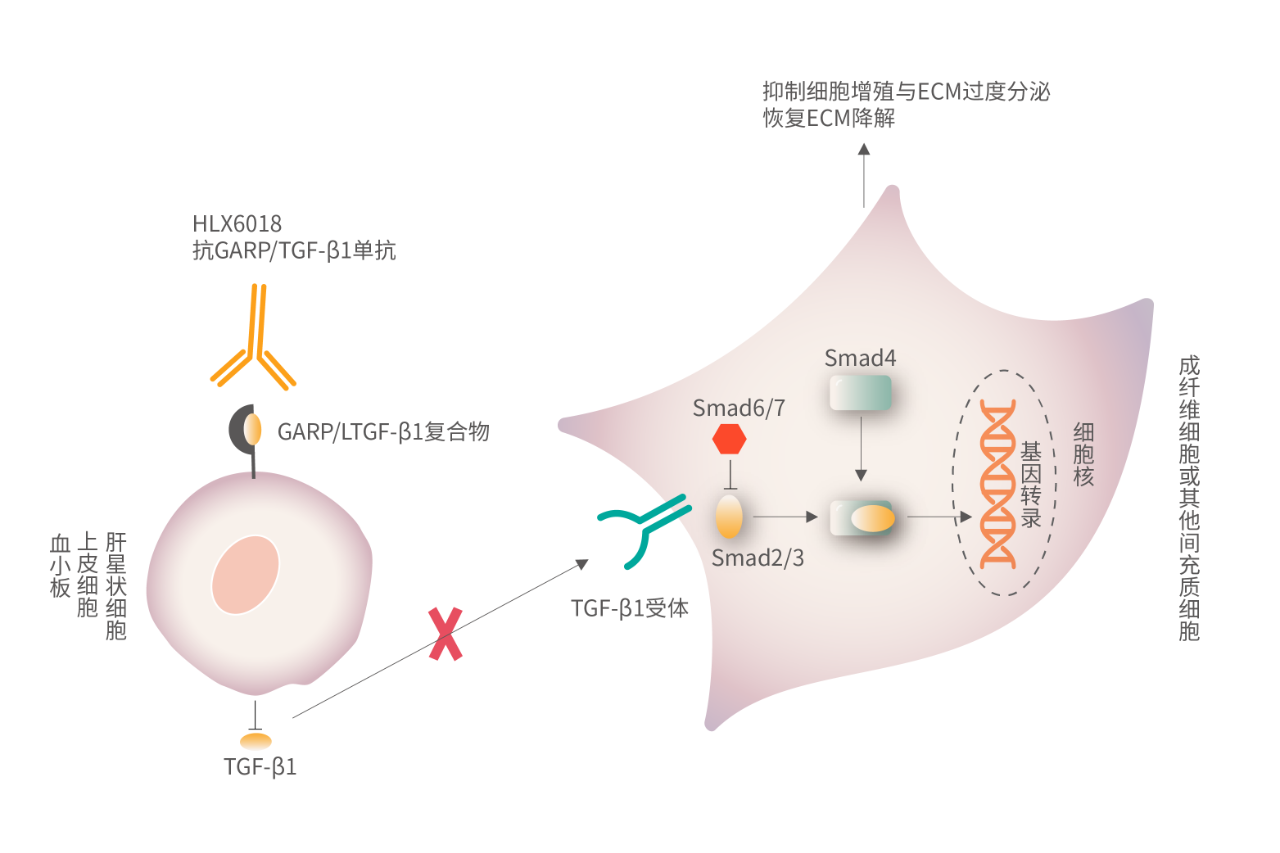Shanghai, China, April 23, 2024 - Shanghai Henlius Biotech, Inc. (2696.HK) announced the first subject was dosed for a phase 1 clinical trial of HLX6018 (NCT06310746), a novel anti-GARP/TGF-β1 monoclonal antibody (mAb) independently developed by the company. HLX6018 is the first innovative product of Henlius in the treatment field of chronic inflammatory diseases, and it was recently approved by the National Medical Products Administration (NMPA) for the treatment of idiopathic pulmonary fibrosis (IPF). Currently, no product targeting GARP/TGF-β1 has been approved for marketing globally.

Fibrosis is a pathological process characterised by persistent tissue scars which attributed to excessive deposition of extracellular matrix (ECM). This condition can be induced by a variety of stimuli such as infections, autoimmune reactions, radiation, and tissue injury. Common fibrosis-related diseases include IPF, non-alcoholic steatohepatitis (NASH)/metabolic dysfunction-associated steatohepatitis (MASH), cirrhosis, chronic kidney disease (CKD), myocardial infarction (MI), etc. [1] Among them, IPF is a chronic, progressive interstitial lung disease with unknown etiology, and was incorporated into the first National List of Rare Diseases in 2018 [2-3]. It is estimated that there are almost 2 million IPF patients in the globe, with its incidence and mortality still rising [4-5]. IPF occurs mostly in elderly men, and the patients suffer from irreversible loss of lung function due to progressive lung fibrosis, which ultimately leads to death. Furthermore, the overall prognosis of IPF is poor, with the median survival of patients is only 3-5 years after diagnosis, and five-year survival rate less than 30%, which is even lower than multiple types of tumour [2]. Currently, treatment options for IPF are very limited, and have just shown their potential for delaying the decline of lung function. There is a large unmet clinical need in the treatment of IPF.
Transforming growth factor-β (TGF-β) is a pleiotropic cytokine and plays critical roles in the initiation and progression of all types of tissue fibrosis. Recent evidence shows that TGF-β1 can induce fibrosis via activation of both Smad-based and non-Smad-based signaling pathways, which result in activation of myofibroblasts, excessive production of ECM and inhibition of ECM degradation [6-8]. Glycoprotein-A repetitions predominant (GARP) is highly expressed on the surface of platelets and other cell types and acts as a docking receptor by binding to latent transforming growth factor-β1 (LTGF-β1). Subsequently, mature TGF-β1 was further activated and released from the GARP/LTGF-β1 complex [9-10].

HLX6018 is Henlius’ self-developed novel anti-GARP/TGF-β1 mAb that binds to GARP/TGF-β1 complex and specifically blocks the release of GARP mediated TGF-β1, thus repressing the fibroblasts proliferation and ECM secretion caused by TGF-β1, and alleviating fibrosis symptoms. In preclinical studies, HLX6018 has demonstrated antifibrotic efficacy in both pulmonary and renal fibrosis models, and has a favorable safety profile. Beyond that, Henlius will continue to explore the efficacy of HLX6018 in a variety of fibrotic diseases including kidney fibrosis and liver fibrosis, steadily enrich the product’s indication layout in antifibrotic area.
Underpinned by the patient-centric strategy and unmet medical needs, Henlius has pro-actively built a diversified and high-quality product pipeline, including over 50 molecules across monoclonal antibody (mAb), polyclonal antibody (pAb), ADC, fusion protein, and small molecule drug, Henlius will continue exploring novel targets and molecular mechanisms in more disease areas and conducting clinical studies for more innovative products to provide patients with quality and affordable biologics.
【Reference】
[1] Wynn T A. Cellular and molecular mechanisms of fibrosis. Journal of Pathology, 2010, 214(2):199-210.
[2] Wu W, et al. BMJ Open 2021; Effcacy and safety of pirfenidone in the treatment of idiopathic pulmonary fbrosis patients: a systematic review and meta-analysis of randomized controlled trials. 11:e050004.
[3] 国家卫生健康委员会等《第一批罕见病名录》
[4] Maher, T.M., Bendstrup, E., Dron, L. et al. Global incidence and prevalence of idiopathic pulmonary fibrosis. Respir Res 22, 197 (2021).
[5] 《中国特发性肺纤维化患者行业发展现状研究与投资前景预测报告》
[6] Meng XM, Nikolic-Paterson DJ, Lan HY. TGF-β: the master regulator of fibrosis. Nat Rev Nephrol. 2016;12(6):325-38.
[7] Ghafoory S, Varshney R, Robison T, et al. Platelet TGF-β1 deficiency decreases liver fibrosis in a mouse model of liver injury. Blood Adv. 2018 Mar 13;2(5):470-480.
[8] Inui N, Sakai S, Kitagawa M. Molecular Pathogenesis of Pulmonary Fibrosis, with Focus on Pathways Related to TGF-β and the Ubiquitin-Proteasome Pathway. Int J Mol Sci. 2021 Jun 5;22(11):6107.
[9] Tran DQ, Andersson J, etc. GARP(LRRC32)is essential for the surface expression of latent TGF-beta on platelets and activated FOXP3+ regulatory T cells. Proceedings of the National Academy of Sciences of the United States of America. 2009; 106(32) :13445-13450.
[10] Metelli A, Wu BX, Riesenberg B, et al. Thrombin contributes to cancer immune evasion via proteolysis of platelet-bound GARP to activate LTGF-β. Sci Transl Med. 2020;12(525): eaay4860.
About NCT06310746
This randomised, double-blind, placebo-controlled, single-dose, dose-escalation phase 1 study aims to evaluate the safety, tolerability, pharmacokinetic characteristics, and immunogenicity of HLX6018 in healthy volunteers. Eligible subjects will be given different doses (0.25 mg/kg, 1.0 mg/kg, 4.0 mg/kg, 12 mg/kg, 25 mg/kg, 50 mg/kg, 70 mg/kg) of HLX6018 or placebo via intravenously infusion. The proposed male to female ratio in each dose group is close to 1:1. After all subjects in each dose group complete dosing and a 21-day safety observation period, the Safety Review Committee (SRC) will assess safety and decide whether to initiate the next dose group. After reaching the pre-planned maximum dose (70 mg/kg), the SRC will decide whether to explore higher dose levels. The primary endpoint of this study is safety evaluation, including the number and incidence of adverse events and serious adverse events, vital signs, physical examination, laboratory tests, and 12-lead electrocardiogram. Secondary endpoints include pharmacokinetic parameters and immunogenicity.
